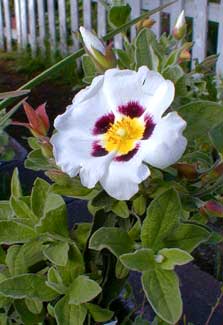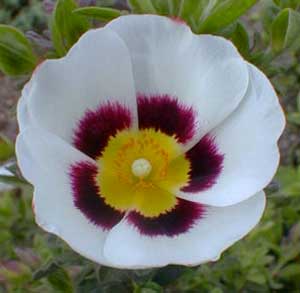
Hillier's Shrubby Rockrose
"God gave us our memories
so that we might have roses in December."
-James Matthew Barrie
(1860-1937)
(1860-1937)
Halimiocistus wintonensis (Hillier) is a recipient of the Award of Garden Merit. It originated as a spontaneous hybrid found among self-sewn rockroses & sunroses at Sir Harold Hillier's Nursery & Aboretum in Wessex, England. It is a cross between Cistus salviifolius & Halimium ocymoides, although it has also been called a cross between C. salviifolius & the cultivar H. lasianthum 'Formosum.'
Blooms occur from May if not by April's end, through the whole of summer, sometimes into autumn, though most strongly in May & June. Each saucer-shaped tricolor blossom is a bit larger than on the average rockrose, white petals having a pearl-sheen around the edges, a reddish maroon spot at the base of each petal, & yellow anthers, perhaps the prettiest of the several sunroses & rockoses that we have.
 Greyish fuzzy evergreen leaves remain attractive year-round. Suited to zones 7-9, it is not the hardiest of rockroses but given a good location it should have no problems. If it isn't going to do well, that'll be obvious after its first winter. If it lasts the first year, it will be around a good many years to follow.
Greyish fuzzy evergreen leaves remain attractive year-round. Suited to zones 7-9, it is not the hardiest of rockroses but given a good location it should have no problems. If it isn't going to do well, that'll be obvious after its first winter. If it lasts the first year, it will be around a good many years to follow.We have two specimens. One is in a street-corner sun garden where it gets bright sun morning & afternoon. The other is in the alley where it gets full sun for half a day only, & grows beside a second shrubby rockrose developed from the "Hillier" original, called 'Merrist Wood Cream,' with faded butter-yellow where the Hillier original is pearly white.
It wants the fullest sunlight area & will decline rapidly in shade. Exposure to high winds especially in winter can be harmful to its winter appearance, so other shrubs in the vincinity to serve as windbreaks will be beneficial.
That it needs well draining soil is an understatement. After its first year it is very drought hardy, but at risk during rainy seasons unless the ground drains deeply. It will do well in poor light soil, or moderately humusy soil, but will be less hardy in soil that is rich & humusy.
Most rockroses are prostrate mounding groundcovers, but this Shrubby Rockrose has much more of an upright habit. Over time it becomes an oval shrub wider than tall. This dwarf shrub rarely exceeds two feet in height, but can spread to three or occasionally four feet, excewpt that it should be hard pruned to a narrower size or it will get unappealingly leggy.
It grows strongly toward the light & if the sun reaches it from only one angle, it will lean more & become leggy, reaching in the sun's direction. With both morning & afternoon sun, it will be a more strongly upright oval shrub.
To keep it compactly leafed, a hard pruning in spring is advisable, but saving enough of the central limb structure to encourage a woody strength.